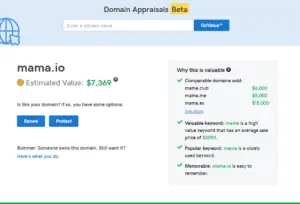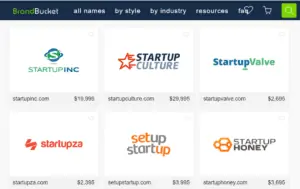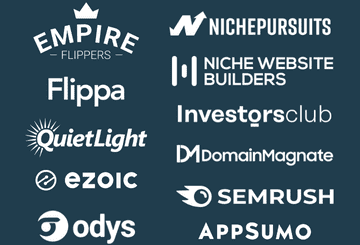Many of us have the habit of registering a domain name whenever we have a great (or not so great) idea for a new startup company, product, project, blog, or side-business. But those ideas often remain just that, an idea.
And the domain name will end up sitting dormant in your registrar account for months, years, or even decades alongside an often growing family of other, unused domain names. These domain names don’t have to stay dormant; starting up a business is incredibly scary, but achievable.
Other reasons for owning unused domain names could be that you retired from or closed a business, decided to stop updating your blog or personal site, or acquired other companies over the years, with their domains.
If so, you’re probably wondering if these domains are worth anything to someone else and if yes, how you can sell your domain names?
How to Sell a Domain Name Fast: My 8-Step Process
In this post, I will guide you through all the different steps in the process of successfully selling a domain name.
From valuation to pricing, marketing, listing, negotiating, and closing a sale with a safe and secure way to transfer the domain name to its new owner and the seller (that will be you) receiving payment.
You can use the links below to jump to a specific section.
- Determine the value of the domain name.
- Price your domain name.
- Make it clear that the domain name is for sale with a For-Sale landing page.
- List your domain for sale on domain marketplaces.
- Sell your domain at auction.
- Find a buyer with outbound sales.
- Hire a domain name broker.
- Use an escrow service for the safe transfer of the funds and the domain name.
Step 1: Determine the value of the domain name.

Before selling a domain name, you first need to figure out how much your domain name is worth.
This is easier said than done and the value of a domain name can range anywhere from a few dollars to numbers in the six or even seven-figure (!) range. The only 100% correct answer is that a domain name is worth whatever a buyer is willing to pay for it but luckily there are some techniques for appraising a domain name that can give you a good idea about the potential value of the domain name if any.
1. Start with studying comparable sales
A great resource to find recent domain names sales and research sales of domain names similar to the ones you own is NameBio.com.
This awesome site offers a historical database containing $1.5 billion dollars in domain name sales and is updated daily to show how much domain names have recently sold across a number of different marketplaces. Use it to your advantage to see how your domain name compares to recent sales.
Use filters for length, keywords and of course extension (such as .com, .net or .io) to narrow down a list of domain names that sold that are similar to yours.
2. Use Domain Appraisal Tools
Another method to get an indicator of the value of your domain is to use an automated domain name appraisal tool such as Estibot or GoDaddy’s GoValue appraisal tool.
Both sites rely on complex algorithms to calculate the value of a domain name based on many different attributes such as domain length, extension, word count, pronunciation as well as SEO-related factors like keywords, the number of searches, monthly searches, and cost per click. Keep in mind that these appraisals are automated and will never be able to account for everything because a domain’s value is not a scientific absolute.
3. Get An Expert Opinion
A third option you have is to ask for an expert opinion.
If the previous two methods both give you a high value for your domain name you might want to consider asking for an expert appraisal by a trusted domain name broker to make sure you price the domain name right.
You also can consider sharing your domain name in the free domain name appraisal section on NamePros, a forum for those that actively buy and sell domain names with the goal to turn a profit. Be prepared for some candid feedback but also keep in mind that not necessarily everyone that leaves a comment is an expert.
Step 2: Price your domain name
Now that you have an indicator of what your domain could potentially sell for it’s time to decide on the right pricing strategy.
Most aftermarket domain names sell in the $2,000 range, and the vast majority of the rest of the domain names that are being purchased on the secondary market go for under $5,000.
So unless you have your hands on a premium domain name that should sell for well into the five or perhaps even six-figures it’s highly recommended you market the domain name with a realistic, “priced to sell”, Buy-It-Now price.
Domains with a Buy Now price are times more likely to sell than the standard “make offer” domains. Another reason to choose this strategy is that a Buy-It-Now pricing creates a sense of urgency for buyers; if they don’t buy now, someone else might and they may lose out on the opportunity to own the domain name forever.
If you own a highly sought-after domain name and enjoy the process of negotiating a deal, there are several reasons to go with the “Make an Offer” approach instead of putting a fixed price on your domain. Receiving offers on your domain name will allow you to do some due diligence on the interested party and find out what their plans with the domain name are and how much they are potentially able and willing to pay to acquire your domain name.
Step 3: List Domain Name with a For-Sale landing page
When someone thinks of a domain name and wants to see if it’s available, what do they do? They type it into their browser. And if you don’t have a crystal clear “this domain is for sale” message on your domain name and an easy way for a potential buyer to contact you, you’re losing out on the biggest opportunity to sell your domain name.
A For-Sale landing page will let any visitor immediately know that your domain name is available for purchase and how to get in touch. There are several ways to create a For-Sale landing page for your domain name.
If you have an existing website you can simply redirect each domain name you own and want to sell to a landing page on that site with an inquiry form. Or you can use a For-Sale landing page from one of the domain marketplace sites such as Sedo or Afternic.
The disadvantage of using those pages is that they often display advertising that can confuse visitors. And when you sell your domain name through a marketplace you have to pay them a commission for the sale, ranging anywhere from 10 up to 30% of the total sales price, – even when your buyer came directly through the domain’s own landing page.
Last but not least, you can use a commission-free, domain name sales platform like Efty. Efty does all the updates, keeps your For-Sale landing pages up and running, and their pages are optimized to help sell domain names.
Step 4: List your domain name for sale on domain marketplaces

If you made it all the way here you’ve already learned about the importance of capturing direct visitors to the domain name with a landing page first and foremost. But this does not mean that listing your domain name for sale on domain marketplaces won’t add value.
Many of the large marketplaces have repeat buyers and a so-called distribution network in which they partner with other websites such as registrars to put your domain name in front of potential buyers across the globe.
Sedo
Sedo has been operating since 2001 and with over 18 million domains listed, Sedo is one of the world’s largest domain marketplaces. The site itself reaches around 2 million visitors per month but they also promote your domain across a large number of partner sites. Listing your domain name for sale with Sedo is free but you pay a commission between 10 and 20% when your domain name sells.
Afternic
This platform was founded in 1999 and listing more than five million domain names available for sale and handling more than 75 million domain searches each month – Afternic is a force to be reckoned with. This marketplace is owned by GoDaddy which is where it gets its big advantage over similar sites. When you list your domain name for sale at Afternic it will also show up as a premium domain when people will search for it on the GoDaddy.com website. Listing a domain name on Afternic is free but you pay 20% commission for a successful sale.
BrandBucket
Do you own a domain name that isn’t necessarily very descriptive but would make a great brand name for a new company, product or service?
If so, BrandBucket might have the right audience to help you land a buyer. This marketplace is curated which means each domain name has to go through a submission and approval process. Once approved, your domain gets listed with a custom designed logo and description which helps potential buyers envision. This marketplace charges a $10 fee to list your domain and requires exclusivity which means you can not sell your domain name elsewhere while you have it listed in the marketplace. With 30% the commission is steep compared to other marketplaces.
Step 5: Sell your domain name at auction (fastest way)
If you’re in the market to sell your domain name quickly, there are a few auction sites waiting to help make it happen. These sites operate in a similar fashion to online auction sites such as eBay. You create a listing, set a reserve price or min openings bid and in some cases a Buy It Now price.
The majority of buyers on domain name auctions sites are domain name investors (individuals who purchase domain names with the sole purpose to resell them for a profit) so you have to be prepared to sell your domain name at so-called “wholesale” or reseller price levels which usually is between 5 to 15% of the “retail” price of a domain name.
GoDaddy Auctions
Godaddy Auctions is GoDaddy’s aftermarket site for secondary domains. The marketplace is very popular with individuals and companies that are looking for exclusive, soon-to-expire domain names to add to their domain name portfolios. The marketplace is visited by 900,000 users every month and with GoDaddy’s status as the world’s #1 domain registrar you are ensured plenty of exposure for your auction listing if your domain name is valuable.
There are several ways to list your domain names including Buy-It-Now with a fixed price, Make Offer or as a 7-day auction. This is your typical online auction. The seller sets a minimum price, bidders battle it out and, when time runs out, the high bidder wins. There is a small ($5) annual membership fee to join the site and when you sell a domain name the commision is anywhere between 10 and 20%.
Flippa
Flippa is primarily a marketplace for buying and selling online businesses but they also have a section for domain name auctions. The site is not as popular as it once was but with 2 million monthly visitors it still is a popular destination and many domain names are sold every day on the site. Listing your domain name for auction cost $9 and listings that are successfully sold will result in a 15% success fee.
One thing that makes Flippa different than other marketplaces is that they allow you to write a detailed description for your auction listing. If you’re interested in learning some of the best practices on how to list, write and promote your listings on Flippa, I recommend this video interview with superseller Ali Zandi. Viewers beware – the video is a couple of years old and much has changed at but some of Ali’s advice around marketing and promoting your auction listings is timeless and more relevant than ever.
Namejet
NameJet is another domain name aftermarket company, operating an auction platform mainly popular among domain name investors. The site has a large number of buyers and moves a huge number of secondary domain names every day. Not everyone can list domain names for sale on NameJet but the site provides an online option to submit your domains for consideration for an upcoming auction.
In order to provide the highest quality of domains to their buyers, they do not auction all names submitted; your names are forwarded and reviewed by the NamesJet team. To submit your domain name you will need to have an active account first. Commission on a successful sale is 15%.
Step 6: Find a buyer with outbound sales

Do you have a descriptive domain name in a niche with many potential end-users? Something like AustinBaker.com or AtlantaLawyer.com.
If the answer is yes, you might want to consider putting in a bit of effort to increase the likelihood of selling your domain name by actively reaching out to relevant businesses that could benefit from owning your domain name.
Outbound sales are typically done via email or phone to a targeted group of leads that have been gathered after some research. The best place to start your research is by doing a Google search for businesses that match the keywords of your domain name.
Once you have a list of businesses gathered you can use tools such as LinkedIn or Clearbit Connect to find the names and email addresses of the person in charge of marketing or technology such as the Chief Marketing Officer or CTO. If a business is small I recommend emailing the owner directly. Make sure to send emails individually, keeping each of them personalized and short.
Such as in the example below.
By keeping things simple and to the point and finish your email with a question you are most likely to generate responses. These can range from “no thank you” to sometimes slightly less polite replies but, if your domain is valuable you will see that you are likely to get a couple of emails back asking you “How much?”.
Need some more tops on outbound techniques from an experienced domain name investor? Check out this blog post by Ali Zandi which is packed with great information to help you get started. And while you’re at it, make sure to read part two in which Ali shares everything you want to know about negotiating and closing the sale.
Step 7: Hire a domain name broker
Does all of the above sound difficult or tiring? Well, I didn’t say this was easy, did I?
If you own a domain name with a significant value you can, and probably should, consider getting a professional domain name broker involved to help you find a buyer and facilitate the sale on your behalf. Most domain brokers work on a commission basis, meaning they are paid a percentage of the sale price.
This no-cure, no-pay structure means most established brokers will only be interested in working with you on finding a buyer for your domain name if it has a value that is at least in the high five-figure range. It is very important that you make yourself familiar with the broker’s policies and pricing structure prior to engaging the services. A written agreement clearly outlining all the nitty-gritty details such as commission and exclusivity is highly recommended.
Below is a list of domain name brokers and brokerage firms with a good reputation and track record:
- Grit
- Buckley Media
- Media Options
- Evergreen
- Starfire Holdings
- NameCorp
- Guta.com (specialized in the Chinese market)
Make sure to do your own due diligence before working with a domain name broker and always use a licensed escrow service to facilitate the sale of the domain name and the transfer of funds.
Step 8: Use an escrow service for the safe transfer of the funds and domain
When buying or selling a domain online, using a licensed and bonded escrow service will reduce the risk for both the buyer and the seller.
Using an escrow service to handle your domain name sale guarantees you get paid and the buyer gets their domain. All of the domain name marketplaces and auction sites referenced throughout this guide offer their own, free escrow service as part of their platform so when you sell a domain name through one of these sites, all you have to do is make sure you are able to transfer your domain name the moment it sells.
But if you sell your domain name through direct negotiation with a buyer or you are using the service of a brokerage firm you should always transact through a licensed escrow company.
The way a domain name escrow works is that both parties agree to the terms of the transaction, which include the domain name(s) and sale price. The buyer will then have to submit a payment for the agreed amount into the escrow account. Once the escrow service has verified and secured the payment, you are instructed to transfer the domain name to the buyer. Once the buyer confirms they have possession of the domain the funds will be released to you.
The most commonly used escrow companies for domain names sales is Escrow.com.



